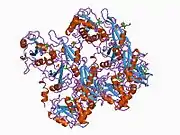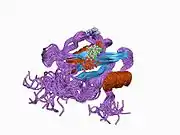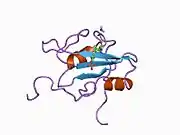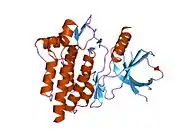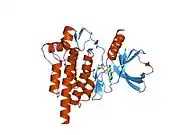Tyrosine-protein kinase SYK, also known as spleen tyrosine kinase, is an enzyme which in humans is encoded by the SYK gene.[5][6][7]
Function
SYK, along with ZAP70, is a member of the Syk family of tyrosine kinases. These cytoplasmic non-receptor tyrosine kinases share a characteristic dual SH2 domain separated by a linker domain. However, activation of SYK relies less on phosphorylation by Src family kinases than ZAP70.[8] SYK and ZAP70 share a common evolutionary origin and split from a common ancestor in the jawed vertebrates.[9]
While Syk and ZAP70 are primarily expressed in hematopoietic tissues, a variety of tissues express Syk. Within B and T cells, respectively, Syk and ZAP70 transmit signals from the B-cell receptor and T-cell receptor.[10] Syk plays a similar role in transmitting signals from a variety of cell surface receptors including CD74, Fc receptor, and integrins.
Function during development
Mice that lack Syk completely (Syk−/−, Syk-knockout) die during embryonic development around midgestation. They show severe defects in the development of the lymphatic system. Normally, the lymphatic system and the blood system are strictly separated from each other. However, in Syk deficient mice the lymphatics and the blood vessels form abnormal shunts, leading to leakage of blood into the lymphatic system. The reason for this phenotype was identified by a genetic fate mapping approach, showing that Syk is expressed in myeloid cells which orchestrate the proper separation of lymphatics and blood system during embryogenesis and beyond. Thus, Syk is an essential regulator of the lymphatic system development in mice.[11]
Clinical significance
Abnormal function of Syk has been implicated in several instances of hematopoietic malignancies including translocations involving Itk and Tel. Constitutive Syk activity can transform B cells. Several transforming viruses contain "Immunoreceptor Tyrosine Activation Motifs" (ITAMs) which lead to activation of Syk including Epstein–Barr virus, bovine leukemia virus, and mouse mammary tumor virus.
SYK inhibition
Given the central role of SYK in transmission of activating signals within B-cells, a suppression of this tyrosine kinase might aid in the treatment of B cell malignancies and autoimmune diseases.
Syk inhibition has been proposed as a therapy for both lymphoma and chronic lymphocytic leukemia. Syk inhibitors are in clinical development, including cerdulatinib and entospletinib.[12] Other inhibitors of B-cell receptor (BCR) signaling including ibrutinib (PCI-32765) which inhibits BTK,[13] and idelalisib (PI3K inhibitor - CAL-101 / GS-1101) showed activity in the diseases as well.[14]
The orally active SYK inhibitor fostamatinib (R788) in the treatment of immune thrombocytopenia.[15]
The Syk inhibitor nilvadipine has been shown to regulate amyloid-β production and Tau phosphorylation and hence has been proposed as a treatment for Alzheimer's disease[16] and has entered phase III clinical trials.[17]
Epithelial malignancies
The role of Syk in epithelial malignancies is controversial. Several authors have suggested that abnormal Syk function facilitates transformation in Nasopharyngeal carcinoma and head and neck cancer while other authors have suggested a tumor suppressor role in breast and gastric cancer.
Without Syk, the protein it makes, and genetic disruption in a panel of 55 genes thought also to be controlled by Syk, breast ductal carcinoma in situ (breast DCIS, which can become invasive), it is believed that the cancer has a markedly increased tendency to invade and metastasize.[18]
Interactions
Syk has been shown to interact with:
References
- 1 2 3 GRCh38: Ensembl release 89: ENSG00000165025 - Ensembl, May 2017
- 1 2 3 GRCm38: Ensembl release 89: ENSMUSG00000021457 - Ensembl, May 2017
- ↑ "Human PubMed Reference:". National Center for Biotechnology Information, U.S. National Library of Medicine.
- ↑ "Mouse PubMed Reference:". National Center for Biotechnology Information, U.S. National Library of Medicine.
- ↑ "Entrez Gene: SYK Spleen tyrosine kinase".
- ↑ Chan AC, Iwashima M, Turck CW, Weiss A (November 1992). "ZAP-70: a 70 kd protein-tyrosine kinase that associates with the TCR zeta chain". Cell. 71 (4): 649–62. doi:10.1016/0092-8674(92)90598-7. PMID 1423621. S2CID 54326428.
- ↑ Ku G, Malissen B, Mattei MG (1994). "Chromosomal location of the Syk and ZAP-70 tyrosine kinase genes in mice and humans". Immunogenetics. 40 (4): 300–2. doi:10.1007/BF00189976. PMID 8082894. S2CID 33774157.
- ↑ Fasbender F, Claus M, Wingert S, Sandusky M, Watzl C (2017-07-07). "Differential Requirements for Src-Family Kinases in SYK or ZAP70-Mediated SLP-76 Phosphorylation in Lymphocytes". Frontiers in Immunology. 8: 789. doi:10.3389/fimmu.2017.00789. PMC 5500614. PMID 28736554.
- ↑ Staal J, Driege Y, Haegman M, Borghi A, Hulpiau P, Lievens L, et al. (2018). "Ancient Origin of the CARD-Coiled Coil/Bcl10/MALT1-Like Paracaspase Signaling Complex Indicates Unknown Critical Functions". Frontiers in Immunology. 9: 1136. doi:10.3389/fimmu.2018.01136. PMC 5978004. PMID 29881386.
- ↑ Mócsai A, Ruland J, Tybulewicz VL (June 2010). "The SYK tyrosine kinase: a crucial player in diverse biological functions". Nature Reviews. Immunology. 10 (6): 387–402. doi:10.1038/nri2765. PMC 4782221. PMID 20467426.
- ↑ Böhmer R, Neuhaus B, Bühren S, Zhang D, Stehling M, Böck B, Kiefer F (March 2010). "Regulation of developmental lymphangiogenesis by Syk(+) leukocytes". Developmental Cell. 18 (3): 437–49. doi:10.1016/j.devcel.2010.01.009. PMID 20230750.
- ↑ Sharman J, Di Paolo J (2016). "Targeting B-cell receptor signaling kinases in chronic lymphocytic leukemia: the promise of entospletinib". Therapeutic Advances in Hematology. 7 (3): 157–70. doi:10.1177/2040620716636542. PMC 4872176. PMID 27247756.
- ↑ Roskoski R (2016). "Ibrutinib inhibition of Bruton protein-tyrosine kinase (BTK) in the treatment of B cell neoplasms". Pharmacological Research. 113 (Pt A): 395–408. doi:10.1016/j.phrs.2016.09.011. PMID 27641927.
- ↑ Cheah CY, Fowler NH (2016). "Idelalisib in the management of lymphoma". Blood. 128 (3): 331–6. doi:10.1182/blood-2016-02-702761. PMC 5161010. PMID 27252232.
- ↑ Scott IC, Scott DL (2014). "Spleen tyrosine kinase inhibitors for rheumatoid arthritis: where are we now?". Drugs. 74 (4): 415–22. doi:10.1007/s40265-014-0193-9. PMID 24610702. S2CID 24168330.
- ↑ Paris D, Ait-Ghezala G, Bachmeier C, Laco G, Beaulieu-Abdelahad D, Lin Y, Jin C, Crawford F, Mullan M (December 2014). "The spleen tyrosine kinase (Syk) regulates Alzheimer amyloid-β production and Tau hyperphosphorylation". The Journal of Biological Chemistry. 289 (49): 33927–44. doi:10.1074/jbc.M114.608091. PMC 4256331. PMID 25331948.
- ↑ Lawlor PB (3 March 2017). "A Phase III Trial of Nilvadipine to Treat Alzheimer's Disease". ClinicalTrials.gov. Retrieved 2017-04-02.
- ↑ Blancato J, Graves A, Rashidi B, Moroni M, Tchobe L, Ozdemirli M, Kallakury B, Makambi KH, Marian C, Mueller SC (2014). "SYK allelic loss and the role of Syk-regulated genes in breast cancer survival". PLOS ONE. 9 (2): e87610. Bibcode:2014PLoSO...987610B. doi:10.1371/journal.pone.0087610. PMC 3921124. PMID 24523870.
- 1 2 Bertagnolo V, Marchisio M, Brugnoli F, Bavelloni A, Boccafogli L, Colamussi ML, Capitani S (April 2001). "Requirement of tyrosine-phosphorylated Vav for morphological differentiation of all-trans-retinoic acid-treated HL-60 cells". Cell Growth & Differentiation. 12 (4): 193–200. PMID 11331248.
- ↑ Lupher ML, Rao N, Lill NL, Andoniou CE, Miyake S, Clark EA, Druker B, Band H (December 1998). "Cbl-mediated negative regulation of the Syk tyrosine kinase. A critical role for Cbl phosphotyrosine-binding domain binding to Syk phosphotyrosine 323". The Journal of Biological Chemistry. 273 (52): 35273–81. doi:10.1074/jbc.273.52.35273. PMID 9857068.
- ↑ Melander F, Andersson T, Dib K (March 2003). "Fgr but not Syk tyrosine kinase is a target for beta 2 integrin-induced c-Cbl-mediated ubiquitination in adherent human neutrophils". The Biochemical Journal. 370 (Pt 2): 687–94. doi:10.1042/BJ20021201. PMC 1223185. PMID 12435267.
- ↑ Oda A, Ochs HD, Lasky LA, Spencer S, Ozaki K, Fujihara M, Handa M, Ikebuchi K, Ikeda H (May 2001). "CrkL is an adapter for Wiskott-Aldrich syndrome protein and Syk". Blood. 97 (9): 2633–9. doi:10.1182/blood.V97.9.2633. PMID 11313252.
- ↑ Ibarrola I, Vossebeld PJ, Homburg CH, Thelen M, Roos D, Verhoeven AJ (July 1997). "Influence of tyrosine phosphorylation on protein interaction with FcgammaRIIa". Biochimica et Biophysica Acta (BBA) - Molecular Cell Research. 1357 (3): 348–58. doi:10.1016/S0167-4889(97)00034-7. PMID 9268059.
- ↑ Kim MK, Pan XQ, Huang ZY, Hunter S, Hwang PH, Indik ZK, Schreiber AD (January 2001). "Fc gamma receptors differ in their structural requirements for interaction with the tyrosine kinase Syk in the initial steps of signaling for phagocytosis". Clinical Immunology. 98 (1): 125–32. doi:10.1006/clim.2000.4955. PMID 11141335.
- ↑ Deckert M, Elly C, Altman A, Liu YC (April 1998). "Coordinated regulation of the tyrosine phosphorylation of Cbl by Fyn and Syk tyrosine kinases". The Journal of Biological Chemistry. 273 (15): 8867–74. doi:10.1074/jbc.273.15.8867. PMID 9535867.
- ↑ Chung J, Gao AG, Frazier WA (June 1997). "Thrombspondin acts via integrin-associated protein to activate the platelet integrin alphaIIbbeta3". The Journal of Biological Chemistry. 272 (23): 14740–6. doi:10.1074/jbc.272.23.14740. PMID 9169439.
- 1 2 Ganju RK, Brubaker SA, Chernock RD, Avraham S, Groopman JE (June 2000). "Beta-chemokine receptor CCR5 signals through SHP1, SHP2, and Syk". The Journal of Biological Chemistry. 275 (23): 17263–8. doi:10.1074/jbc.M000689200. PMID 10747947.
- ↑ Saci A, Liu WQ, Vidal M, Garbay C, Rendu F, Bachelot-Loza C (May 2002). "Differential effect of the inhibition of Grb2-SH3 interactions in platelet activation induced by thrombin and by Fc receptor engagement". The Biochemical Journal. 363 (Pt 3): 717–25. doi:10.1042/0264-6021:3630717. PMC 1222524. PMID 11964172.
- ↑ Thome M, Duplay P, Guttinger M, Acuto O (June 1995). "Syk and ZAP-70 mediate recruitment of p56lck/CD4 to the activated T cell receptor/CD3/zeta complex". The Journal of Experimental Medicine. 181 (6): 1997–2006. doi:10.1084/jem.181.6.1997. PMC 2192070. PMID 7539035.
- ↑ Sidorenko SP, Law CL, Chandran KA, Clark EA (January 1995). "Human spleen tyrosine kinase p72Syk associates with the Src-family kinase p53/56Lyn and a 120-kDa phosphoprotein". Proceedings of the National Academy of Sciences of the United States of America. 92 (2): 359–63. Bibcode:1995PNAS...92..359S. doi:10.1073/pnas.92.2.359. PMC 42739. PMID 7831290.
- ↑ Sada K, Minami Y, Yamamura H (September 1997). "Relocation of Syk protein-tyrosine kinase to the actin filament network and subsequent association with Fak". European Journal of Biochemistry. 248 (3): 827–33. doi:10.1111/j.1432-1033.1997.00827.x. PMID 9342235.
- ↑ Dustin LB, Plas DR, Wong J, Hu YT, Soto C, Chan AC, Thomas ML (March 1999). "Expression of dominant-negative src-homology domain 2-containing protein tyrosine phosphatase-1 results in increased Syk tyrosine kinase activity and B cell activation". Journal of Immunology. 162 (5): 2717–24. doi:10.4049/jimmunol.162.5.2717. PMID 10072516.
- ↑ Deckert M, Tartare-Deckert S, Couture C, Mustelin T, Altman A (December 1996). "Functional and physical interactions of Syk family kinases with the Vav proto-oncogene product". Immunity. 5 (6): 591–604. doi:10.1016/S1074-7613(00)80273-3. PMID 8986718.
- ↑ Song JS, Gomez J, Stancato LF, Rivera J (October 1996). "Association of a p95 Vav-containing signaling complex with the FcepsilonRI gamma chain in the RBL-2H3 mast cell line. Evidence for a constitutive in vivo association of Vav with Grb2, Raf-1, and ERK2 in an active complex". The Journal of Biological Chemistry. 271 (43): 26962–70. doi:10.1074/jbc.271.43.26962. PMID 8900182.
Further reading
- Turner M, Schweighoffer E, Colucci F, Di Santo JP, Tybulewicz VL (March 2000). "Tyrosine kinase SYK: essential functions for immunoreceptor signalling". Immunology Today. 21 (3): 148–54. doi:10.1016/S0167-5699(99)01574-1. PMID 10689303.
- Fruman DA, Satterthwaite AB, Witte ON (July 2000). "Xid-like phenotypes: a B cell signalosome takes shape". Immunity. 13 (1): 1–3. doi:10.1016/S1074-7613(00)00002-9. PMID 10933389.
- Yanagi S, Inatome R, Takano T, Yamamura H (November 2001). "Syk expression and novel function in a wide variety of tissues". Biochemical and Biophysical Research Communications. 288 (3): 495–8. doi:10.1006/bbrc.2001.5788. PMID 11676469.
- Tohyama Y, Yamamura H (2006). "Complement-mediated phagocytosis--the role of Syk". IUBMB Life. 58 (5–6): 304–8. doi:10.1080/15216540600746377. PMID 16754322. S2CID 41684033.
- Schymeinsky J, Mócsai A, Walzog B (August 2007). "Neutrophil activation via beta2 integrins (CD11/CD18): molecular mechanisms and clinical implications". Thrombosis and Haemostasis. 98 (2): 262–73. doi:10.1160/th07-02-0156. PMID 17721605. S2CID 41094726.
External links
- Syk+kinase at the U.S. National Library of Medicine Medical Subject Headings (MeSH)
- Overview of all the structural information available in the PDB for UniProt: P43405 (Tyrosine-protein kinase SYK) at the PDBe-KB.







